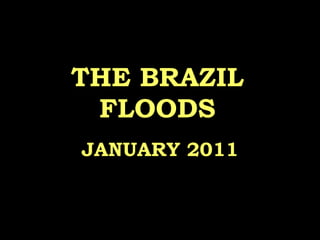
Brazil Floods 2011 Disaster Kills 900
- 1. THE BRAZIL FLOODS JANUARY 2011
- 2. Between January 11 and January 12, more rainfall fell in Brazil’s state of Rio de Janeiro than usually falls in a month.
- 3. The immediate result was flooding.
- 6. Teresopolis, 62 miles north of Rio de Janeiro was the worst hit. ‘It is the biggest catastrophe in the history of the town’ said the Mayor.
- 7. A 55 year old maid described the scene as being ‘like a horror film’ and said she saw a baby ‘carried away by a torrent like a doll’ as the child’s mother tried in vain to save it.
- 8. Thousands of people in the affected regions were cut off from electricity and telephone contact and 1000 people in Teresopolis alone lost their homes. In Sao Paulo, the state capital and brazil’s biggest city, major roads flooded, paralyzing main thoroughfares. People died in collapsed homes.
- 9. In Sao Paulo, the state capital and Brazil’s biggest city, major roads flooded, paralyzing main thoroughfares. People died in collapsed homes .
- 10. Downpours dislodged hillsides which enveloped houses, hotels, roads and churches in a sea of mud. Eventually 903 people were reported to have died, with over 17 000 left homeless.
- 11. One man, after seeing the water-damaged and badly decomposing body of his father, chose to stop searching for his wife and son’s bodies. ‘Let those buried beneath us rest in peace.’ he said. He began carrying supplies to neighbours. ‘We have to help the living’ he said . TRAGIC STORIES AND SIGHTS WERE EVERYWHERE :
- 12. People in mountainous areas were cut off from towns for days. Initially firefighters tried to help, at least 5 losing their lives in mudslides.
- 13. Eventually help came from helicopters as roads were cut off by the floods. Often in the two weeks following the flash flood, helicopters were grounded by more heavy rain .
- 15. In the year before the tragedy ‘not even half of the budget intended for the prevention of disasters was used.’ Money set aside for drainage was not used!
- 16. The real cause of the tragedy was the ‘failure of the authorities.’ Debarati Guha-Sapir, the director of the World Health Organization’s Collaborating Centre for Research on Disasters said:
- 17. ‘ Rains are natural phenomena, but these people died because they have no political weight whatsoever, and there is no political will to resolve their dramas, which are repeated year after year.’
- 18. ‘ What drives the poorest people to dangerous areas is a longstanding housing policy in Brazil’, said Justice Minister Jose Cardozo. ‘ In addition to the question of rainfall, we have a social question.’ ‘The government has failed to provide any public housing alternative! House prices are beyond the reach of the vast majority.’
- 19. COMPARISON OF DEATHS BETWEEN RICH AND POOR AREAS: Richer areas have better, stronger infrastructures. In Santa Catarina state only 5 dies even though 17 000 fled their homes. In the richest state in the country Sao Paulo, 25 people died.
- 20. But in the poorer regions, where people lived on mountain sides, over 800 people died.
- 21. Brazil needs urban planning to plan long term to avoid forseeable tragedies.
- 23. In Brazil the January 2011 floods have threatened Brazil’s most important coffee and sugar production. Brazil is the world’s leader in coffee production and is the largest per capita sugar-producing nation in the world: excessive rainfall and flooding could hurt crop production and the ability to harvest the crop.
- 28. The more likely culprit was a pocket of above average sea-surface temperatures in the southwest Atlantic that promoted low atmospheric pressure and an increased tendency for heavy rainfall.